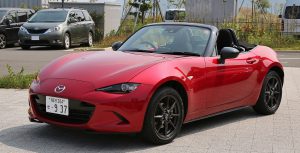 History
History
The Mazda MX-5 (known as Miata in the United States) can be credited with starting the rebirth of the classic small two-seat roadster. By the time of its introduction in 1989, the British roadsters by brands such as MG and Triumph were no longer in production. The Mercedes-Benz R129 was introduced at about the same time, but this was a much larger luxury car. The MX-5 was heavily inspired by the Lotus Elan.
The first generation, known as NA, was produced from 1989 to 1997. Engine offerings were a 115 hp (later 90 hp) 1.6l and, starting in 1994, a 1.9l with 130 hp – both coupled to a short-shifting five-speed manual transmission. Other important ingredients were double-wishbone suspension on all four wheels (like in Formula 1, not McPherson front suspension like on most cars) and a weight of less than 1,000kg. As a result, the MX-5 is considered one of the best-handling cars ever made.
The second generation, NB, was produced from 1998 to 2005. The car lost the pop-up headlights and gained some curves and approx. 100kg in weight, mostly due to improved stiffness and crash protection. The 1.6l now developed 110hp, the 1.9l around 140hp.
The third generation, NC, was produced from 2005 to 2015. The styling was a bit closer to the NA. The suspension was now based on the RX-8’s, with the rear axle going from double wishbones to a multilink suspension. Weight was increased by about 50kg. The 1.8l engine developed 126 hp. The 2.0l engine came with limited-slip diff, optional 6-speed transmission, and 160 hp.
The fourth and current generation (ND) was introduced in 2015. It is 10cm shorter and about 100kg lighter than the NC, dipping just below 1,000kg weight in the 1.5l model. The 1.5l engine develops 130hp. The 2.0l continued with 160hp, but was uprated to 184hp (ND2 model) in 2018.
Performance
Acceleration figures for the sprint to 100kph range from 10.6s for the 90hp NA to 6.5s for the 184hp ND2. Top speeds range from 175kph to 220kph. But this is only part of the story. With a weight of 950kg-1150kg, the mX-5 is much lighter than most other rear-wheel drive cars (e.g. all BMWs) of the last decades. Combined with an excellent suspension and gearbox (never buy an automatic!), this makes for a very fun car to drive, and it’s hard to beat the fun that can be had with it at road-legal speeds.
Pros
- Lightest mass-produced rear-wheel drive car of the last 30 years
- One of the last cars on a dedicated rear-wheel drive sports car platform
- Very good transmission and suspension
- Cars and parts are plentiful
Cons
- Not very powerful, especially NA and NB models
- No coupé available
My pick
All generations have their charms. If you want the smallest and lightest and have a thing for pop-up headlights, go NA. The NB is probably better value for money, but looks a bit dated. Some people dislike the NC for its added weight, but most of that has gone into making it a better car, and I like the looks better than the NB. The ND2 offers the most performance. So, if money were no object, I’d go for the ND2. Otherwise the 1.8l NB or 2.0l NC.